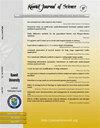Microplastics' occurrence, distribution, and chemical toxicity in backwater sediments from Puducherry Coast, Southeast India
IF 1.1
4区 综合性期刊
Q3 MULTIDISCIPLINARY SCIENCES
引用次数: 0
Abstract
Microplastics (MPs) are degraded particles (≤5.0 mm) that originate from macro-sized plastics that significantly impact ecosystems due to their extensive fragmentation. These lighter particles, impacted by various environmental factors, become negatively buoyant and sink into sediments. In the current study, the vertical distribution of MPs from three distinct locations along the Puducherry coastal region, Ariyankuppam River Bridge (S1), Thengaithittu Fishing Harbor (S2), and Chunnambar Beach (S3), was investigated. The three sediment core samples ranging from 0 to 10 cm depth were bifurcated into five sub-samples of 2 cm intervals. The MPs exhibited a gradually decreasing abundance with increasing depth. Higher MPs were observed within the top 0–2 cm sediment samples. The average MP concentration in S1, S2, and S3 sediments was 138.5 MP cm−2, 107.5 MP cm−2, and 118.0 MP cm−2, respectively. The most dominant MPs identified in sediments were fibers, fragments, and film with the major composition of polyethylene (PE), polypropylene (PP), and polyethylene terephthalate (PET). The MPs exhibited morphological changes, including irregular cracks, micro-brittles, pores, and erosion-like amorphous characteristics, potentially threatening marine organisms. Samples from S1 had a high pollution risk index (1,25,230) and polymeric hazards. All the sampling sites recorded a high contamination factor (CF ≥ 6) of sediments due to high levels of MPs. The present study emphasizes the need for deeper sediment sampling to gain valuable insights into MPs within global budgets.

印度东南部普杜切里海岸回水沉积物中微塑料的发生、分布和化学毒性
微塑料(MPs)是来自宏观塑料的降解颗粒(≤5.0 mm),由于其广泛破碎,对生态系统产生重大影响。这些较轻的颗粒受到各种环境因素的影响,变得负浮力并沉入沉积物中。在本研究中,研究了沿Puducherry沿海地区Ariyankuppam河大桥(S1)、Thengaithittu渔港(S2)和Chunnambar海滩(S3)三个不同地点的MPs垂直分布。3个沉积物岩心样品深度为0 ~ 10 cm,分为5个2 cm的亚样品。MPs丰度随深度的增加而逐渐降低。在顶部0-2 cm的沉积物样品中观察到较高的MPs。S1、S2和S3沉积物中MP的平均浓度分别为138.5 MP cm−2、107.5 MP cm−2和118.0 MP cm−2。沉积物中最主要的MPs是纤维、碎片和薄膜,主要成分是聚乙烯(PE)、聚丙烯(PP)和聚对苯二甲酸乙二醇酯(PET)。MPs表现出形态变化,包括不规则裂缝、微脆、孔隙和侵蚀样无定形特征,对海洋生物具有潜在威胁。S1样品具有较高的污染风险指数(1,25,230)和聚合物危害。由于MPs含量高,所有采样点沉积物的污染系数(CF≥6)均较高。目前的研究强调需要进行更深入的沉积物采样,以便在全球预算范围内获得对MPs的有价值的见解。
本文章由计算机程序翻译,如有差异,请以英文原文为准。
求助全文
约1分钟内获得全文
求助全文
来源期刊

Kuwait Journal of Science
MULTIDISCIPLINARY SCIENCES-
CiteScore
1.60
自引率
28.60%
发文量
132
期刊介绍:
Kuwait Journal of Science (KJS) is indexed and abstracted by major publishing houses such as Chemical Abstract, Science Citation Index, Current contents, Mathematics Abstract, Micribiological Abstracts etc. KJS publishes peer-review articles in various fields of Science including Mathematics, Computer Science, Physics, Statistics, Biology, Chemistry and Earth & Environmental Sciences. In addition, it also aims to bring the results of scientific research carried out under a variety of intellectual traditions and organizations to the attention of specialized scholarly readership. As such, the publisher expects the submission of original manuscripts which contain analysis and solutions about important theoretical, empirical and normative issues.
 求助内容:
求助内容: 应助结果提醒方式:
应助结果提醒方式:


